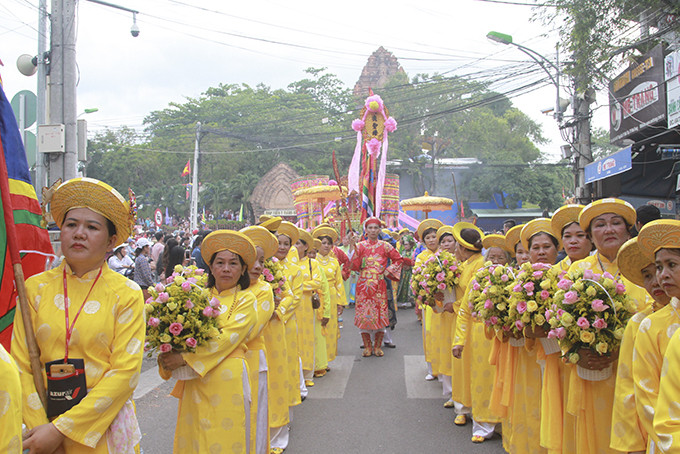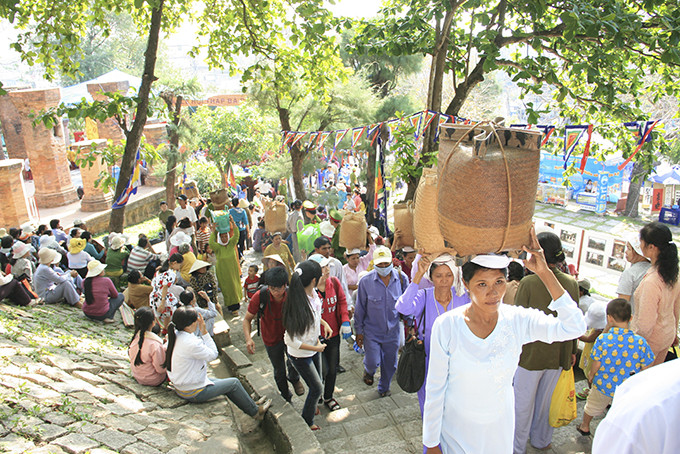
Around 1,000 traditional festivals are organized in Khanh Hoa Province at different scales. 3 out of 1,000 festivals are the nation-level cultural heritages namely Ponagar Temple Festival, Grave-Leaving Ceremony of Raglai people in Khanh Son District and Whale Worshipping Festival. Besides, there are many large-scale festivals such as Am Chua Festival and Salanganest Nest Festival.
Around 1,000 traditional festivals are organized in Khanh Hoa Province at different scales. 3 out of 1,000 festivals are the nation-level cultural heritages namely Ponagar Temple Festival, Grave-Leaving Ceremony of Raglai people in Khanh Son District and Whale Worshipping Festival. Besides, there are many large-scale festivals such as Am Chua Festival and Salanganest Nest Festival.
Grave-Leaving Ceremony
Raglai people in Khanh Son District consider Grave-Leaving Ceremony the most important ceremony because this ritual marks the eternal separation between the living and the dead. The ceremony usually takes place in 3 days, but nowadays, it can be shortened depending on the circumstances of each house. The ceremony is still practiced in the communities of Raglai people in Khanh Son District and some localities. In order to prepare for the ceremony, families select a date and time, prepare for brewing Can wine (wine drunk out of a jar through pipes); erect ceremony stalls; and make graves, etc. Many ritual acts are performed in Grave-Leaving Ceremony. Besides, there are Ma La performances and grave decoration by kagor technique (wooden boat model is placed on the roof of graves).

|
In 2012, the Ministry of Culture, Sports and Tourism recognized Grave-Leaving Ceremony Raglai people in Khanh Son as a national intangible cultural heritage.
Am Chua Festival
Together with Ponagar Temple Festival, Am Chua Festival vividly demonstrates the worship of Mother Goddesses of Khanh Hoa people. Am Chua Festival takes place at Am Chua Monument located on Dai An Mountain (Dien Dien Commune, Dien Khanh District) from lunar March 1 to 3 every year. The festival includes activities such as offering incense and flowers to show gratitude to the Holy Mother; traditional ritual acts performed by the elders in the region; worship acts performed in 3 days of the festival.

|
Whale Worshipping Ceremony
Whale Worshipping Ceremony originated from the worship of whales of people in coastal localities. In Khanh Hoa, Whale Worshipping Ceremony is solemnly organized in coastal villages with full traditional ritual acts every year. In the festival, fishing boats are decorated with colorful flags and flowers and parade on the sea. The ceremony also includes performances of Ba Trao, a typical form of festive dancing and singing showing the solidarity of fishermen at sea and wishes for productive fishing.

|
In 2012, the Ministry of Culture, Sports and Tourism announced that Khanh Hoa was one of the typical localities which were still practicing Whale Worshipping Ceremony and recognized the festival as a national intangible cultural heritage.

|
Ponagar Temple Festival
Ponagar Temple Festival is a largest scale traditional festival in Khanh Hoa, taking place at Ponagar Temple from lunar March 20 to 23 every year. The festival includes nine major rituals such as changing clothes and cleaning statues and offering incense. In 2012, the Ministry of Culture, Sports and Tourism recognized Ponagar Temple Festival as a national intangible cultural heritage.

|

|
Salanganest Nest Festival
Salanganest Nest Festival is a special festival bearing typical features of Khanh Hoa people, taking place on lunar May 10 at Hon Noi Island in Nha Trang Bay. The ceremony was originally organized to commemorate the founders of salanganes nest business. Over the past years, Khanh Hoa State-owned Salanganes Nest One-Member Company Limited has organized the festival at a higher level. At the ceremony, attendees review the history of formation and development of salanganes nest business, offer incense to commemorate the merit of progenitor, Rear Admiral Le Van Dat and islands’ owner, Holy Mother Le Thi Huyen Tram.

|
According to legend, in 1328, during a military trip to the southern region, Admiral Le Van Dat of Tran Dynasty discovered the caves of the salanganes in the sea area of Nha Trang. He formed a group of people to protect, exploit and develop this resource. That was how salanganes nest industry was established, and Admiral Le Van Dat has been worshiped by later generations as the ancestor of salanganes nest industry in Vietnam. Those who were considered to be the successors of the salanganes nest industry were Le Van Quang and his daughter Le Thi Huyen Tram. In the reign of Tay Son Dynasty, Le Thi Huyen Tram was appointed the general of an army and administrator of the islands where salanganes nested. On May 10, 1793, Le Thi Huyen Tram and her father laid down their life in the war to protect the sovereignty of the nation’s territorial waters and the islands. Since then, local people organize a ceremony on lunar May 10 to commemorate the death anniversary of Holy Mother Le Thi Huyen Tram and Tay Son soldiers.

|

|
Giang Dinh - Song Dang
Translated by H.N






